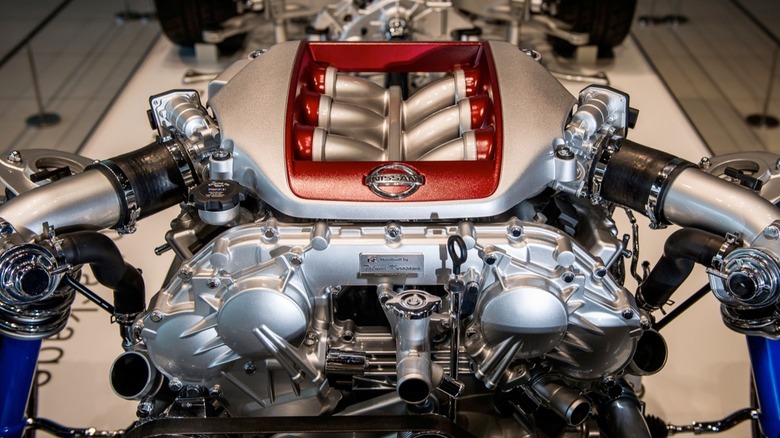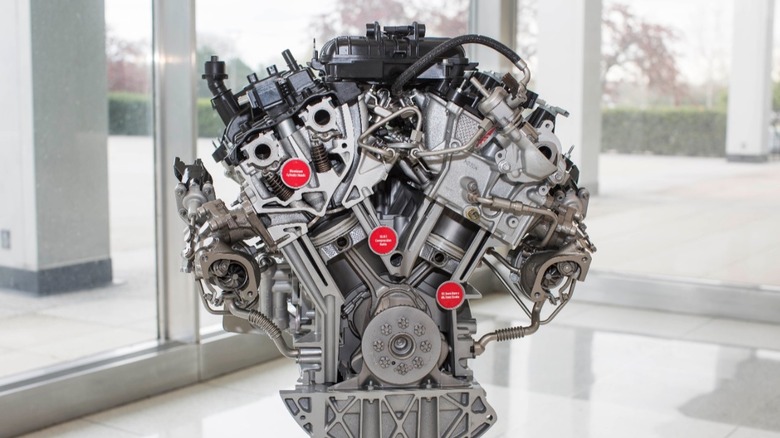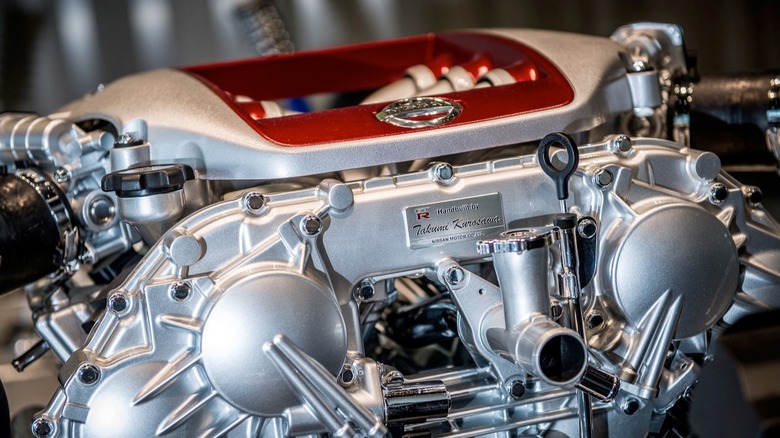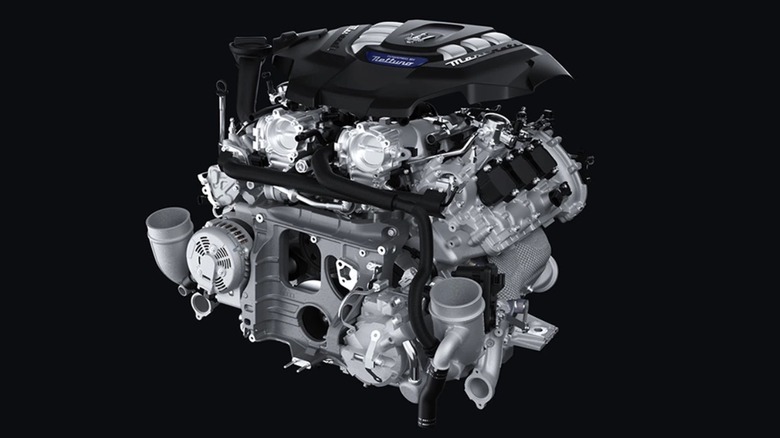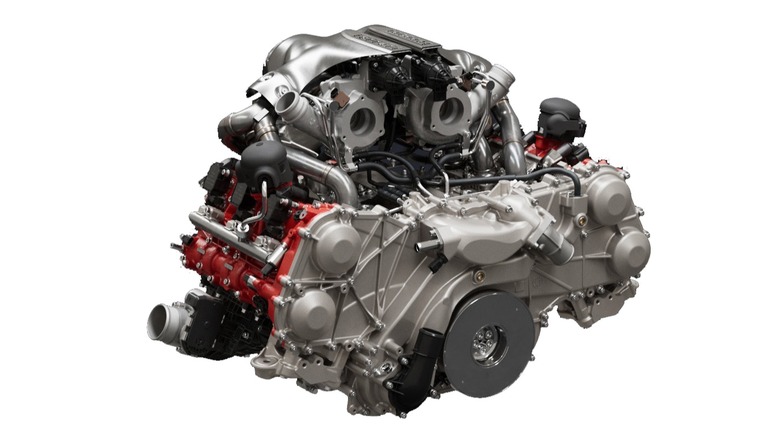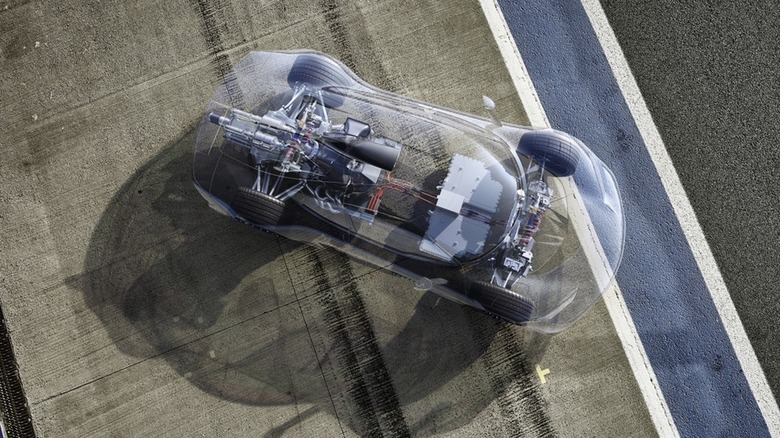These V6 Engines Have More Horsepower Than An LS1 V8
The V8 engine is on the endangered species list today. As of 2020, only 15.3 percent of new cars on the road used a V8 powertrain, compared to nearly 28 percent in 2005. The dramatic falloff of eight-cylinder engines can largely be attributed to increasingly strict fuel economy requirements and the rise of electric vehicles that are equally as, and often more, powerful than the dino-burners that they are replacing. As unfortunate as that is in the eyes of enthusiasts, it is the future we face. Even before the age of vast electrification, manufacturers were moving away from V8s in favor of more efficient engines, but they did so by lobbing off cylinders.
While production V6 engines have been around since 1950, the rise of V8-rivaling V6s began in the 1960s and 1970s when U.S. manufacturers began offering large-displacement V6s alongside their V8 options. Engines like the Buick Fireball V6, GMC 305 V6, and GMC big block 478 V6 – which remains the largest displacement V6 ever made — began to pose a real threat to V8 supremacy. While V8s still ran the table through the remainder of the 1960s, the 1973 oil crisis forced manufacturers to take fuel-efficient V6s a bit more seriously.
By the mid-1980s, factory V6s were getting even more powerful thanks to forced induction, with engines like the Buick 3800 producing more power than the 5.7L V8 in the 1987 Corvette. That trend continued into the 1990s, and into the era of the third-generation GM small block that would initiate its reign with the LS1 in 1997. Despite the LS1's impressive peak 350 horsepower output, there have been a number of V6 engines that have wiped the floor with the legendary V8.
3.5L EcoBoost - 647 horsepower
The Ford EcoBoost is the perfect example of a V6 platform truly challenging the V8 offerings by the same manufacturer. The EcoBoost formula was a step towards revolutionizing Ford's engine lineup with the goal of making the smallest displacement, most efficient, and most powerful engines possible. To aid in that, the EcoBoost pulled tested engine technologies from previous engines and tied them all together in one coherent package, using twin turbochargers, direct injection, and variable camshaft timing to get the most out of the package.
The 3.5L EcoBoost was the first engine in the EcoBoost lineup and was introduced for the 2010 model year under the hoods of the Lincoln MKS & MKT, Ford Flex, Taurus, and Explorer Sport. In all of those applications, the EcoBoost was mounted transversely, which would change when the 3.5L V6 featured in the F150 was mounted longitudinally, speaking to the versatility of the engine. In its initial form, the 3.5L EcoBoost was capable of 355 horsepower in the Lincoln MKS, producing five more horsepower than the venerable LS1 even before the EcoBoost's significant updates in 2015 which dramatically increased its output, efficiency, and durability.
The 2015 and beyond 3.5L EcoBoost is known as the "Gen 2," which is a very different engine from the initial 3.5L, featuring dual direct and port fuel injection, upgraded turbochargers, timing upgrades, and valvetrain improvements. The Gen 2 3.5L EcoBoost launched in the 2016 Ford GT, producing nearly twice the initial engine's output with 647 horsepower. Tuned-down versions of the Gen 2 High-Output 3.5L EcoBoost have been used in the 2017+ Ford F150 and Ford Raptor, producing 450 horsepower at its peak in those models.
Nissan VR38DETT - 600 horsepower
Nissan has a storied history of producing supercar-thrashing six-cylinder engines. The most obvious example of Nissan's six-cylinder supremacy is its RB engine series, found most commonly in Skyline models. Engines like the 280 horsepower RB25DET NEO and falsely reported "276 horsepower" RB26DETT allowed R32, R33, and R34 Skylines to hold up, and sometimes surpass, even the greatest V8 supercars of the time. Those were both inline sixes, though. Nissan's modern V6 legacy starts with the VQ engine series, initially released in 1995. Nissan's VQ series of V6 engines is well known for being used in cars like the 350z and Infiniti G35, in addition to a number of other SUVs and passenger cars. While the VQ provided enough grunt for lower-tier models, topping out at 311 horsepower, it wasn't enough to live up to the GT-R legacy when the R35 debuted in 2007.
Instead of using the VQ in the R35 GT-R, Nissan used it as a building block to a new high-performance V6 engine. Like the VQ engine series, the VR38DETT is a V6 engine, but punched out to 3.8 liters and fed by twin-turbos. Each individual engine was hand-assembled by four master craftsmen, speaking to the quality of the engines themselves. When the R35 GT-R was initially released in 2007, the VR38DETT produced a peak of 480 hp and 430 lb-ft of torque. Even in its base form, the VR38DETT made 130 more horsepower than the LS1 V8. Nissan wasn't done there, though. In the years following the engine's release, it was updated to include higher boost pressure, revised intake and exhaust manifolds, and other hardware and software changes. The alterations made a significant difference in terms of output, with the 2022 GT-R NISMO producing 600 horsepower.
Maserati Nettuno V6 - 621 horsepower
Maserati has used quite a range of engines in its time as a manufacturer. From 2001 until 2023, almost every Maserati product featured a Ferrari-supplied powerplant. The F136 V8 was Ferrari's main contribution to Maserati's powertrain department, which was used in everything from the Quattroporte to the Gran Turismo from 2001 to 2019, albeit in a slightly altered form. Ferrari also provided Maserati with a cross-plane crank version of its F154 twin-turbo V8 from 2015 until 2023 when it was announced that the House of the Trident would be venturing out on its own to develop engines.
While V8 engines have been Maserati's trademark since 1939, the first engine that it developed solo was a twin-turbo V6, and a dang good one at that. The engine itself was developed for Maserati's new flagship supercar, the MC20, harkening back in spirit to the legendary MC12. It's clear that Maserati wanted to make a splash with it, too, with the engine being the MC20's centerpiece. It is a highly advanced piece of engineering that features a cutting-edge, Formula 1-style pre-chamber ignition system. It works by igniting a fuel and air mixture before the combustion chamber, which then rapidly ignites combustion in the cylinder. The inclusion of the pre-chamber ignition system adds another 120 horsepower compared to a standard ignition system design, making the Nettuno V6 ludicrously efficient. The end result is a 621 horsepower twin-turbo V6 that produces fewer emissions than an equivalent V8 while still getting the MC20 to 60 mph in 3.2 seconds.
Ferrari F163 V6 - 819 horsepower
Even Ferrari is losing cylinders as time goes on. At one point in time, Enzo Ferrari was quoted saying that "a Ferrari is a 12-cylinder car," taking that so literally that V6 and V8 offerings by the prancing horse were called Dinos instead — not as a slight, but out of principle. However, that sentiment changed with the introduction of the Ferrari 308 GTB in 1975, which was the first production Ferrari (technically) to feature a V8 engine. Ferrari embraced the V8 for many years after the 308 GTB, with mid-engined V8 Ferraris still remaining its premier offerings to this day. However, a new challenger entered the frame in 2021 with two fewer cylinders. Ferrari's F163 was an entirely new design when it debuted in the 296 GTB, featuring two valley-mounted turbochargers, an electric motor, and 819 horsepower.
Production hot-vee turbocharged engines have been around since BMW introduced the concept to the world with its N63 V8 in 2008, but the formula has been getting more and more popular as the technology has advanced. Ferrari implemented a hot-vee layout in its new V6 by increasing the bank angle to 120 degrees, allowing for enough room for the two turbochargers and exhaust manifolds. The hot-vee arrangement allows for better turbo response and efficiency. Ferrari also threw in an axial-flux electric motor, adding another 165 horsepower to the equation. Compared to the V12-powered 812 Superfast, which Ferrari was selling at the same time that the F163 was introduced, the 296 GTB produced 30 more horsepower with half the cylinders. The LS1 is well and truly in the rearview at this point on the list, as the F163 makes 469 more horsepower than the 5.7L V8.
Mercedes Formula 1 V6 - 1,049 horsepower
From 2006 to 2013, Formula 1 used 2.4L V8 engines that were extremely popular due to their immense power and screaming exhausts. During that period, F1 was already looking for ways to move in a more environmentally conscious direction, with the introduction of kinetic energy recovery systems in 2009 technically making the cars hybrids. Despite electrifying the V8s, Formula 1 didn't see that as a dramatic enough step, announcing that V6 turbo-hybrid engines would take their place in 2014.
Formula 1's switch to V6 hybrid engines marked a seismic shift for the sport. While environmental concerns were a major reason for the change in power units, showcasing new technology was another big reason. With brake energy harvesting MGU-K and e-turbo MGU-H systems accounting for 160 horsepower and the insane jumps in engine efficiency made over the years, V6 turbo-hybrid engines make more power than the V8 engines that they replaced in Formula 1. When the new engine regulations went into effect in 2014, no team did it better than Mercedes. As a result of its superior turbo-hybrid V6 — in addition to its general cohesion as a team — Mercedes won eight consecutive constructors' championships between 2014 and 2021.
To celebrate the engine that brought the team so much success, Mercedes took the 1.6L turbo-hybrid V6 out of its Formula 1 car and adapted it for its new flagship road car. While there have been road cars that have used F1-derived engines in the past — like the BMW E60 M5 or Ferrari F50 — the AMG One is the most true-to-form example. Just like with Mercedes Formula 1 cars, the AMG One features both MGU-H and MGU-K systems in addition to four electric motors, bringing its total to 1,049 horsepower.
